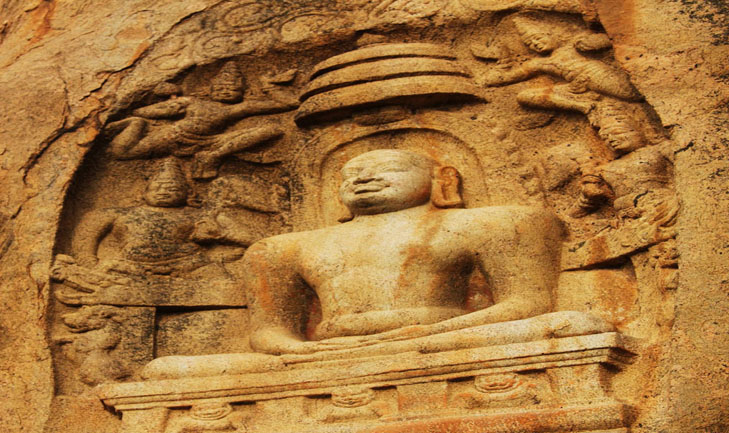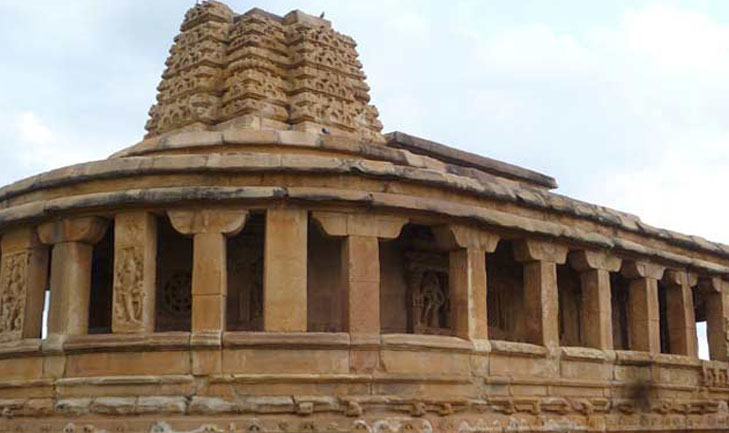Meguti Jain Tirth - Bh. Mahavira
 |
Aihole, Karnataka
Antiquity : 6th-7th Century
Location : Aihole has Convenient Road access. It is 15 Miles from Pattadakal, 25 Miles from Badami and about 300 miles from Bangalore.
Though now a small Village, Aihole was once the early capital of the Badami Chalukyan. Empire. Situated some 25 miles from Badaini, on the banks of the Malaprabha River, Aihole is considered the cradle of Hindu and Jain temple architecture. During the 5th Century A. D. this place was a great centre of trade, education and religion. All the temples at Aihole have been declared protected monuments under the Archeological Survey of India.
The architectural range seen in the temples of Aihole, is reflective of the early experimental phase of development of the Hindu & Jain style of temple architecture, as it evolved from simple rock cut shrines to large and complicated structures. The architectural extravaganza at Aihole was the artistic outcome of the patronage of the erstwhile Chalukyan Rulers, who were great builders, The reign of the Chalukya in central Karnataka from 535 to 757 A. D. saw major architectural developments of this region as well as a flowering of fine arts & literature. The temples in Aihole tell us about how temple architecture developed in various stages for many centuries.
The Jain & Hindu temples of Badami, Patadakal & Aihole shows the unique architectural style of that period. Aihole is dotted with more than one hundred structures, testimonials to the experiments undertaken by the Chalukyan architects towards the evolution of the Hindu & Jain style of temple architecture. The fully evolved temples are manifestations of the embryonic stages of the South Indian (Dravidian) style of temple architecture that fully developed later on. Each of the early temples at Aihole has its own architectural feature. The names given to the temples are quite interesting. The names do not stand for the main deties of these temples, but represent either the persons who lived in them or their location.
There are almost 125 stone temples and two cave temples, divided into 22 groups scattered around the village out of which the Durga Temple, Lad Khan Temple & Meguti Temple are the most impressive. The Meguti Jain Temple is prominently located on top of the highest hill in Aihole and was built in the year 634 A. D. From a historic standpoint the inscription dating the monument is found on the eastem outer wall of the temple and records its construction by Ravikeerti, who was a commander and minister under the famous Chalukya King Pulkeshi II. Meguti Temple is the only dated monument in Aihole, provides an important evidence of the early development of the Dravidian style of Architecture. On1y two of the original sculptures have survived; a large seated idol of Lord Mahavira & a partly mutilated but still convincingly beautiful goddess Ambika.
The Meguti temple, situated on the hillock, is built on an elevated platform. It has two sanctums, a court hall and a portico. A stone ladder carved out at the portico provides access to the roof. This flight of stairs leads to another shrine on the roof, directly above the main shrine. From the roof, one can have a panoramic view of the hundred temples of Aihole. A pillared corridor runs around the temple, enveloping the shrine. Its beautiful motifs and richly carved images on stone reflect the earliest development of Jain a art and architecture.
 |
-----------------------------------------------------
Information Source : Jaina Calendar - 2004, Published By Jaina, USA
-----------------------------------------------------
Mail to : Ahimsa Foundation
www.jainsamaj.org
R110204